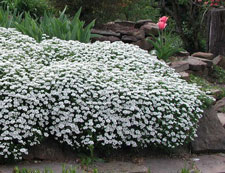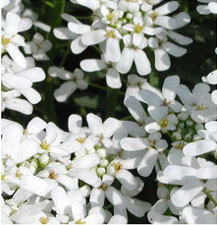Resource Library
Plant of the Week: Candytuft
The University of Arkansas System Division of Agriculture does not promote, support or recommend plants featured in "Plant of the Week." Please consult your local Extension office for plants suitable for your region.
Plant of the Week
Candytuft
Latin: Iberis sempervirens

Candytuft is blooming in my garden, and as happens each spring, I wonder why it's not more popular.
To Americans, candytuft is Iberis sempervirens, the sprawling evergreen subshrub used for edging and in the rock garden. For Europeans, it's more likely to be one of the annual candytufts such as I. umbellata. Iberis belong to the cabbage family and, especially for the annual sorts, they have distaste for summer heat.
Iberis sempervirens is a spreading plant growing 8- to 12-inches tall and spreading to 2 feet across. It's completely evergreen with linear, entire, deep green leaves usually about an eighth-inch wide and 2 inches long.
Candytuft produces dense clusters of white blooms in round, flattened terminal racemes in mid-spring. Individual blossoms are four-petaled with the lower pair of petals two to three times as large as the upper pair. The blooming season is about three to four weeks.
Iberis sempervirens is considered the most garden-worthy of the 45 species of candytufts that are widely distributed throughout southern Europe, North Africa and the Mediterranean region. The name was first applied by Linnaeus in 1753 and tells us a lot about the plant. The genus name Iberis is a place name for the Iberian Peninsula (Spain), the home of many species. The epitaph translates as “always green,” or evergreen.

The common name is an adaptation of another place name, in this case Candia, a name used during the 16th century for modern day Crete. Seeds of the first Iberis grown in England were sent to the herbalist John Gerard from Crete by Lord Edward Zouche, an avid gardener who traveled abroad from 1583 to 1587. Zouche was councilor for the Virginia Company that was granted a charter to establish colonies in the New World.
Candytuft is hardy from zones 3 through 8 and is easy to grow if planted in full sun in about any well-drained garden soil. It will tolerate light shade, but blooming will be reduced. Root and crown rot are common problems in poorly drained sites.
The evergreen candytuft was first promoted in American garden catalogs during the height of the Victorian era where it was recommended for edging formal flower beds. Today, it's more commonly used in rock gardens, especially in situations where it can cascade over a rock face. It also makes a good groundcover for small areas.
To maintain compactness and encourage good bloom, plants should be sheared back by one-third as soon as the blooms fade. 'Nana' and 'Little Gem' are dwarf forms under 4 inches in height. 'Alexander's White', 'Snowflake' and 'Purity' are more compact and floriferous selections than average seed grown plants. 'Autumn Snow' and 'Snowflake' are repeat bloomers and will flower in the spring and fall.
By: Gerald Klingaman, retired
Extension Horticulturist - Ornamentals
Extension News - May 2, 2008
The University of Arkansas System Division of Agriculture does not maintain lists of retail outlets where these plants can be purchased. Please check your local nursery or other retail outlets to ask about the availability of these plants for your growing area.